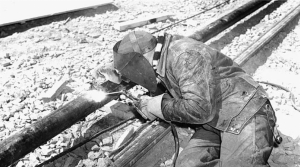
History of compliance for welding

In the late 1920s and early 1930s, the welding of pressure vessels came on the scene. Welding is made possible due to the low structural efficiency of the riveted joint.
Welding was widely utilized by industry as it strove to increase operating efficiencies by the use of higher pressures and temperatures, all of which meant thick-walled vessels. As welding began to be used, a need for non-destructively examining those welds emerged. In the 1920s, inspectors tested welds by tapping them with hammers, then listening to the sound through stethoscopes. A dead sound indicated a defective weld.
By 1931, the revised Boiler Code accepted welded vessels judged safe by radiographic testing. By this time, magnetic particle testing was used to detect surface cracks that had been missed by radiographic inspection.
Welding Codes & Standards
The welding industry has many codes and standards that must be met in order to have safe and reliable welding processes. Welding compliance procedures facilitate a safe work environment. At the same time, the control of the welding documentation and its implementation are essential.
Our certified welding inspectors can perform various qualification and testing services accordingly to standards in order to verify that the welder is capable of making welds within the scope of that your welding coupons are accurate in the welding procedure.
What Are The Three Types Of Welding Procedure Specification?

- Preliminary Welding Procedure Specification (PWPS)
The welding manufacturer initially drafts a preliminary welding procedure (PWPS) which is used by one of the manufacturer’s competent welders to prove that it is capable of producing a welded joint to the specified levels of weld quality and mechanical properties.
It specifies the types of materials, type of weld configuration, test piece size, welding processes to be used, welding consumables to be used, and all the necessary welding parameters.
- Welding Procedure Specifications (WPS)
A Welding Procedure Specification (WPS) is a document, which provide information on the qualified ranges of essential welding variables, which will produce satisfactory weld in regard to the welder’s skill. Additionally, the document will contain proven and tested procedures that cover information including weldability, material compatibility, suitable method of joining and etc.
Welding Procedure Specifications are an essential document to ensure welds used in creating a structure will be safe and compliant.
- Standard Welding Procedure Specification (SWPS)
SWPS is a welding procedure that has been qualified by testing and has a proven track record of assuring quality. It is approved by the Welding Research Counsel. It is similar to WPS and has supporting procedure Qualification Records (PQRs) which comply with the rules set forth by AWS B2.1.
PTS’s Process to Qualify Welding Procedure Specifications
To determine standards or codes to be followed
To determine customer’s requirements, weld design and product design
Prepare pWPS and carry out welding according to pWPS
Record all detail during welding, with 3rd party witnesses if required
Send out weld coupon to test laboratory for testing with 3rd party witness
Once welding coupon passes all tests, complete welding PQR
Get witnesses to endorse PQR and pWPS
Endorse pWPS thereafter becomes a qualified WPS
Why is it important to inspect compliance for welding?

Uncovering weld discontinuities is important because imperfections may be within or adjacent in the weld. Defects such as loss of strength or stress concentrations may prevent the weld from meeting its intended function.
Compliance to welding codes is prerequisite to obtain the necessary welding certification. Without this, companies will not be allowed to place their products onto the market.
Our team of certified welding inspectors can reduce the rate of error for welds. We will guarantee that your project is tailored to all the requirements of relevant welding codes, ensuring its quality.









